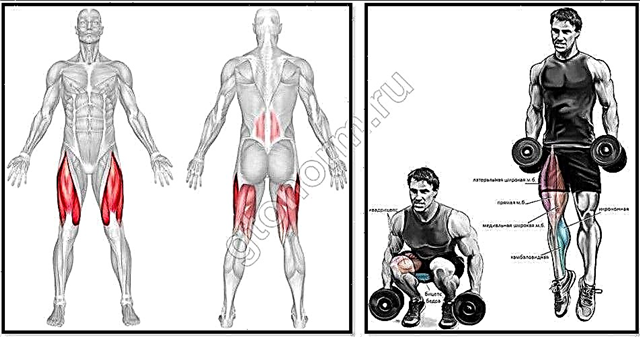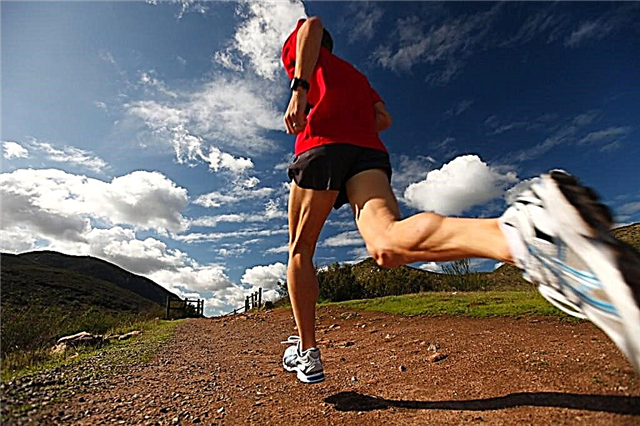Exercises for the press will not give any effect if performed without a systematic approach and the required level of knowledge! Today we will tell you something without which it will be impossible to pump a quality press!
The abdomen is a complex mechanism, its role is not only to restrict and protect the internal organs, but together with other muscles of the cortex, it stabilizes the hips, pelvis and spinal column.
Working abdominal muscles help maintain balance, improve posture and reduce injury. With any physical activity, the abdominal muscles are one of the first to work - they help to fix and support the spine.
Today we will tell you which ab exercises are the most effective and how to get the most out of each workout!
The structure of the abdominal press

The front wall of the abdomen is formed by a long paired muscle - the rectus abdominis muscle, its two parts are divided along the midline of the abdomen, and not at all across, as is commonly believed; upper and lower press - the division is conditional, not anatomical. This muscle helps the spine to bend, is involved in lowering the chest and raising the pelvis.
On the sides are the transverse muscle and oblique (external and internal) abdominal muscles. They are responsible for bending and twisting, protecting the vertebral discs from displacement.
Types of abs exercises
You can (and should) load muscles statically and dynamically.
- Dynamic load involves repeated repetition of the exercise, the muscles tense and relax. Such loads allow you to build muscle mass, improve the work of the cardiovascular system, and speed up metabolism.
- If the exercise requires fixing a given position of the body for as long as possible - we are talking about static loads, they increase endurance, strengthen tendons, joints and even increase immunity.
To achieve the best results, it is worth combining both types of loads.

If the goal is to lose a little weight, it is better to distribute the load in favor of dynamic loads, planning 60-70% of the training time for them, and leave the static at the end of the training.
Beginners in sports also should not rush with static loads, strength and endurance may not be enough. It is better to add them in the second or third week of training.
If you want expressive cubes on the press, working only with your own weight is not enough, an integrated approach is required:
- Even thin belly fat can hide your abs. The solution is proper nutrition. No amount of exercise can replace healthy eating habits. In case of excess weight, a special diet may be required.
- In order for the cubes to be well traced on the torso, it is required to increase the muscle mass of the press, this can be achieved using dynamic loads with weights. Rest between such trainings should be about two days, so that the muscle fibers have time to recover.
Often, girls are advised to give up training with additional weights, predicting an increase in waist volume due to an increase in muscle mass. This warning when doing ab exercises is typical for men, the female body reacts to stress in a different way due to the peculiarities of the anatomy and hormonal balance. The waist in women can expand in the case of an excessive number of repetitions in one approach, and only if there is a genetic predisposition to this (a special structure of the abdominal muscles).
You can also work out the press with indirect exercises for the press (at home). Squats are well suited for this purpose, the effectiveness of the training will increase the barbell for weight. Despite the fact that the main load falls on the back and legs, the abdominal muscles are also actively working.
Another effective indirect exercise is the deadlift. It is similar to the barbell squat, requiring knees to be extended and flexed, but in the case of the deadlift, the weight is in the arms rather than the shoulders. These are trainings for experienced athletes who have already pumped their core muscles enough; beginners should start with simpler loads.
Abs exercises for beginners

To begin with, you should understand the basic mistakes of novice athletes:
- Neglecting warm-up and stretching. Running, jumping rope, rotating arms, legs and head - all these exercises will prepare the muscles for the load and accelerate the transmission of nerve impulses. After warming up, it is necessary to consolidate the plasticity of the muscles; this requires stretching. Preparing your muscles and joints properly before training will help prevent injuries and sprains.
- Performing exercises with a relaxed press. You need to feel your muscles; during loads, the press should be tense and involved in work.
- Incorrect technique. During the load, the press should work, and not the legs or back. It is better to do the exercise 12 times, observing the technique, than to perform a hundred movements in a convenient but incorrect way. Therefore, before starting training, it is worth figuring out how to correctly do the selected abdominal exercises.
- Improper breathing. The general rule of all exercises: inhalation should be done at the time of the least muscle effort, exhalation - when the exercise requires the greatest muscle tension. Do not hold your breath or take frequent shallow breaths - muscles need oxygen to work and burn fat.
- Irrational choice of loads. After training, a beginner should be pleasantly tired, you should not do 100 squats, twists and push-ups on the first day of classes. If the training is not tired at all, then either the load is insufficient, or the exercises were performed incorrectly.
- Lack of a system in the classroom. Rare classes, regular absenteeism or training "swoops", on a busy week every six months - will not bring visible results. If you exercise too often, damaged muscle fibers will not have time to recover.
The basic exercises for the press for beginners include: from static exercises - a bar and vacuum, from dynamic - twisting, scissors, corner, rock climber. All trainings have several options.
It is better to plan the first workouts from dynamic exercises in the classic version. By practicing at least 3-4 times a week, after a few weeks you can add a bar and vacuum.
Usually, beginners are recommended to use a "strength" or "multi-repetition" training scheme - do all the exercises in two or three sets of 20-50 times (more is possible), depending on individual capabilities. The recommended break between sets is from 30 seconds to 2 minutes.

Such a training scheme will improve the condition of the abdominal press. After 2-3 months, you can stop at the achieved level and switch to working out other muscle groups. If the task is to continue to pump the abdominal muscles, then you need to move from light exercises to the press for beginners to more complex trainings. For these purposes, as a rule, "strength" training complexes are used, designed for a small number of repetitions and a significant expenditure of strength.
Advanced exercises
The muscles quickly get used to the initial loads, training no longer gives an increase in strength and mass - additional stress is required. The first step to making training more difficult is to use weights.
Additional weights can be applied to all simple abdominal exercises, for example, simple leg raises from a prone position are much more effective when weights are tied to the shins. When working with weights, you must follow the rule: to increase muscle volume, an average number of repetitions with a small burden is done, to increase strength requires large weights and a small number of repetitions (up to 12).
Mike Mentzer, in search of the most effective exercises for the press, developed a system of high-intensity training (HIT), he suggested repeating the exercise in one approach for as long as there is strength. This state is called "refusal" - lack of physical strength for one more repetition of the exercise. Performing 1-2 sets "to failure" and taking long breaks between workouts - from three to five days - the athlete gets the opportunity to achieve a rapid increase in muscle mass. In this approach, the training regime is more important than the choice of exercises.
There is no single best abdominal pumping exercise. It all depends on the degree of fitness, on individual characteristics and even preferences - some like to raise their legs on the horizontal bar, others prefer twisting.
It is important to consider that if you only deal with the abdominal press, then the result will be a disproportionate body; professional trainers recommend working evenly with all muscle groups.

There are two approaches to holistic training:
- "Full body" - exercises for all muscle groups are planned in one workout. This approach is recommended for beginners; for experienced athletes, this scheme requires a large number of repetitions and approaches.
- Split - dividing the workout loads. There are many types of exercise distribution, most often the body is conventionally divided into groups (as a rule, these are the back, arms, abs, shoulders and chest) and only one muscle group is worked out in one workout. In the process of increasing fitness, muscles require more and more one-time load and longer recovery time, the split allows you to take this feature into account.
You can find specialized split programs for a specific muscle group, including the press. With this approach, the abdominal press is pumped more often and more actively than other parts of the body.
Effective abs exercises
You don't have to look for the most difficult exercises to build abs. There are a number of simple trainings that have been tested by time and athletes, the main requirement for the exercise is that the target muscle must be fully involved in the work, and you can always increase the load with the help of weights or the use of sports equipment.
Twisting
The starting position for straight twisting: lying on your back, hands should be placed behind the head, legs bent at the knees. It is required to pull the shoulder girdle to the pelvis, rounding the back, and stay in this position for a few seconds, then slowly return to its original position. This exercise should not be confused with "torso lifts" - when twisting, the lower back should not come off the floor. This technique effectively pumps the upper and lower rectus abdominis muscle. If oblique abdominal muscles require work, then you can use diagonal twists. Starting position lying on your back, calves on a bench (or any convenient elevation), hands behind your head. It is required to twist the right elbow towards the left knee, linger for a few seconds (the lower back is pressed to the floor). Return to starting position, then repeat with left elbow towards right knee.
Plank
The easiest option - leaning on the elbows and toes of the legs, you need to straighten the body; it is necessary to be in this position for at least 30 seconds. The duration of the load can be gradually increased. There are options for the plank on straightened arms, with a raised leg and / or arm. Such loads tone the core muscles.
Rock climber
This exercise works out almost the entire muscle corset, sometimes athletes use it to warm up. The starting position is a plank on straightened arms. It is necessary to alternately pull the knees to the chest, making sure that the abs are tense all the time. The faster the pace of the exercise, the more effective it is.
Corner
This exercise has many options, united by a common condition: it is required to maintain a certain angle between the hips and the body due to the abdominal muscles. The easiest way is to raise your outstretched legs while lying on the floor and hold them in this position as much as possible. A more difficult option is sitting on the floor, hands are parallel to the body, palms on the floor. It is required, leaning on your hands, to raise the body above the floor, legs are extended forward, while the pelvis is shifted slightly backward. It is necessary to stay in this position and return to the starting position. This training improves the endurance of all abdominal muscles.
Scissors
Lying on your back, stretch your arms along the body, hide your palms under the buttocks. It is necessary to raise your legs above the floor by 10-20 cm and cross your legs. The lower back should remain relaxed. With this training, you can work out the rectus muscle and the external oblique muscles of the abdomen.
This is one of the best exercises for pumping up the press, a full study of the muscles is achieved only with an integrated and systematic approach.
Fitness accounts
Today, you don't have to go to the gym to get professional advice or chat with like-minded people. Athletes and coaches willingly share their experiences on Instagram and youtube, on their pages you can find a detailed analysis of exercises for pumping up the press, photos and video materials.
Elena Silka and her youtube channel "happybodytv". The trainer posts detailed and understandable videos, a separate section of the blog is devoted to working out the press. She maintains an Instagram page @happybody_home, where she regularly opens an entry for online marathons.
Yanelia Skripnik is another fitness trainer, her youtube channel "FitnessoManiya" is dedicated to weight loss, the section "workouts for the press" offers training complexes and a detailed analysis of all the subtleties of working out the abdominal muscles.
Alla Samodurova and her Instagram @allsfine_workout. The selections of training schemes that she lays out are designed for home conditions.
On the youtube channel "I'm losing weight with Ekaterina Kononova", almost four dozen videos about working out the press are collected in a separate playlist. In the selection you can find training complexes for weight loss, a thin waist and a flat stomach. Ekaterina maintains an Instagram page @ kononova1986, where she briefly and to the point talks about diet nutrition and uploads training records.
Fitness trainer Tatyana Fedorishcheva on her youtube channel "TGYM" not only collected workouts for muscle groups, but also prepared a lot of material for beginners.









